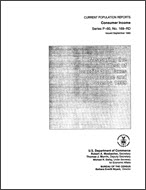
An official website of the United States government
Here’s how you know
Official websites use .gov
A .gov website belongs to an official government organization in the United States.
Secure .gov websites use HTTPS
A lock (
) or https:// means you’ve safely connected to the .gov website. Share sensitive information only on official, secure websites.
-
//
- Census.gov /
- Library /
- Publications /
- Measuring the Effect of Benefits and Taxes on Income and Poverty: 1989
Measuring the Effect of Benefits and Taxes on Income and Poverty: 1989
Measuring the Effect of Benefits and Taxes on Income and Poverty: 1989
Abstract
This report gives detailed data on persons, families, and households by income and poverty levels by age, sex, race, Hispanic origin, education, work experience, and program participation status. This report brings together benefit and tax data that previously appeared in separate publications.
For the first time, data are based on experimental techniques that allocate income values to noncash benefits, such as Medicare and Medicaid coverage, school lunches, food stamps, rent subsidies, employer contributions to health insurance plans, and the imputed income flow acquired from home equity.
The report presents data on the characteristics of income distribution measures by definition of income (before and after taxes, cash and noncash transfers, and capital gains) and cross classifies the income information for all households; those with White, Black, and Hispanic origin householders; related children under 18 years and those under 6 years; and households with members 65 and 75 years and older. Data also are given for married-couple householders with related children under 18 years and under 6 years; married-couple households with White, Black, and Hispanic origin householders; those with children under 18 years and under 6 years; and households with a female householder, no husband present.
The report provides data by selected characteristics and definitions of income, for persons, families, and unrelated individuals in poverty. It also contains data on the mean income deficit for families and unrelated individuals in poverty.
The report includes tables that show income of households from specified sources, such as food stamps, housing assistance, and free or reduced-price school lunches, for all households and those households with householder living in poverty.
A Note on Language
Census statistics date back to 1790 and reflect the growth and change of the United States. Past census reports contain some terms that today’s readers may consider obsolete and inappropriate. As part of our goal to be open and transparent with the public, we are improving access to all Census Bureau original publications and statistics, which serve as a guide to the nation's history.
Others in Series
Publication
Publication
Publication
Share
Related Information
Some content on this site is available in several different electronic formats. Some of the files may require a plug-in or additional software to view.
 Yes
Yes
 No
NoComments or suggestions?


Top

